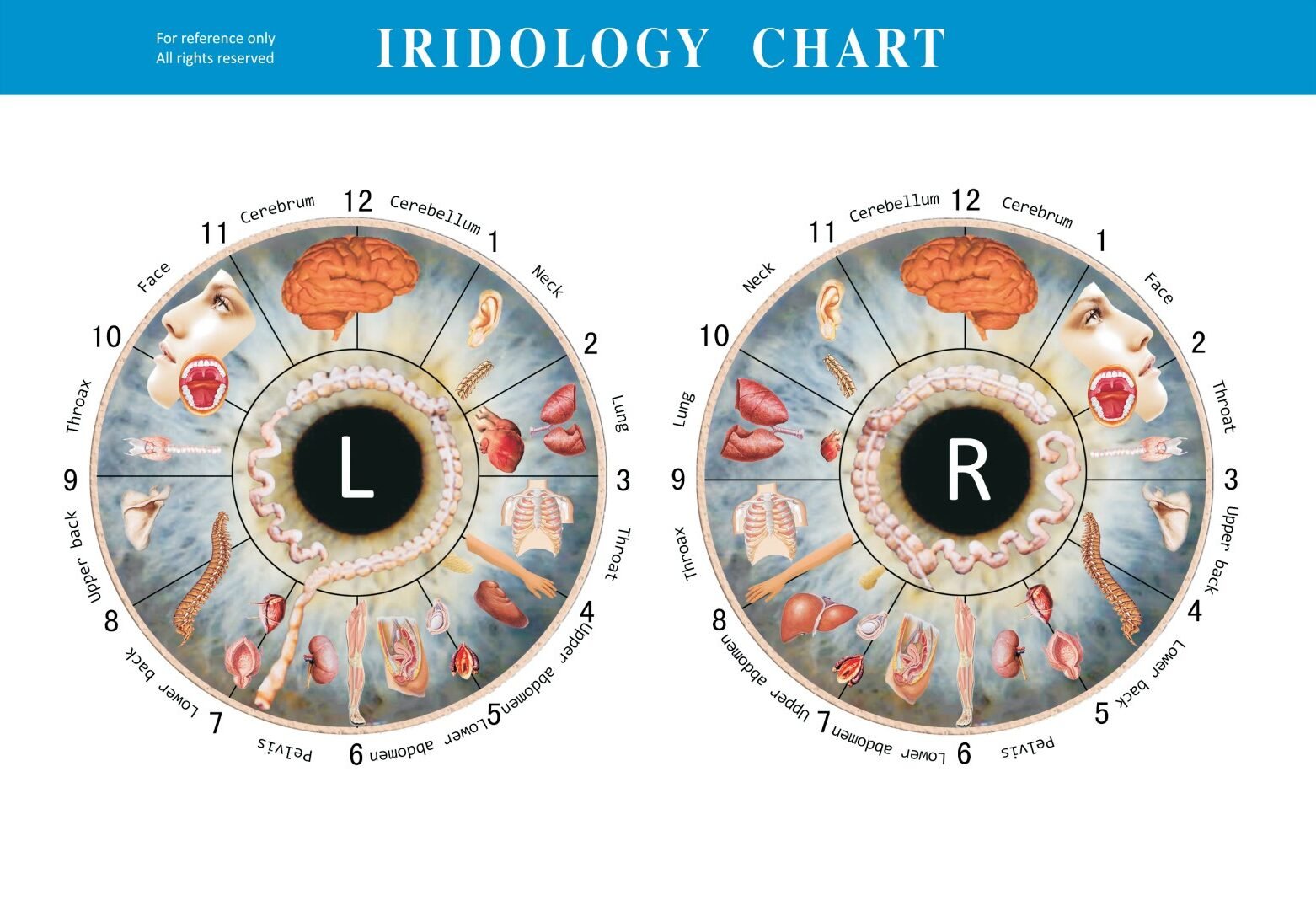Die Iridologie ist eine faszinierende alternative Gesundheitspraxis, die Muster, Farben und andere Merkmale der Iris untersucht, um die allgemeine Gesundheit einer Person zu bewerten. Im Zentrum dieser Praxis steht das Iridology Eye -Diagramm - eine detaillierte Karte, mit der Praktiker bestimmte Regionen der Iris mit entsprechenden Körpersystemen und Organen verbinden. Dieser Leitfaden führt Sie durch die Grundlagen der Iridologie -Charts, wie man sie liest und welche Wissenschaft zu dieser faszinierenden, aber kontroversen Praxis zu sagen hat.
Eine typische iridologische Eye -Diagramm -Mapping -IRIS -Regionen zu entsprechenden Körpersystemen
Was ist ein iridologisches Augendiagramm?
Eine iridologische Augenkarte dient als Karte, die die Iris in mehrere Zonen unterteilt, die jeweils verschiedenen Teilen des menschlichen Körpers entsprechen. Diese Diagramme sind wesentliche Instrumente für Iridologen, die die Iris analysieren, um potenzielle gesundheitliche Bedenken zu identifizieren, bevor sie sich als körperliche Symptome manifestieren.
Die moderne Iridologie-Diagramm wurde in den 1950er Jahren vom amerikanischen Chiropraktiker Bernard Jensen entwickelt, obwohl die Praxis selbst bis ins 19. Jahrhundert zurückreicht, als der ungarische Arzt Ignaz von Peczely zuerst Korrelationen zwischen Irismarkierungen und Gesundheitsbedingungen dokumentierte. Heute bleiben diese Diagramme für die Praxis der Iridologie weltweit von grundlegender Bedeutung.


Bernard Jensens einflussreiches iridologisches Diagramm, das heute noch weit verbreitet ist
Anatomie eines iridologischen Diagramms
Iridologische Diagramme teilen typischerweise jede Iris in ungefähr 80-90 Zonen auf und erstellen eine detaillierte Karte, die mit verschiedenen Körpersystemen korreliert. Das Verständnis der Grundstruktur dieser Diagramme ist für alle, die sich für diese ganzheitliche Praxis interessieren, von wesentlicher Bedeutung.
Zonen und Regionen
Die Iris ist in mehrere konzentrische Ringe und kuchenförmige Sektoren unterteilt. Jede Zone entspricht einem bestimmten Organ- oder Körpersystem. Das Diagramm ist mit jedem wie ein Uhr Gesicht organisiert “Stunde” verschiedene Körperteile darstellen. Zum Beispiel erscheint die Leber typischerweise in der rechten Iris zwischen 8 und 9 Uhr.


Uhrähnliche Abteilungen eines iridologischen Diagramms mit Organrealkorrespondenzen
Unterschiede für das linke und rechte Auge
In der Iridologie repräsentieren die linken und rechten Iris verschiedene Seiten des Körpers:
Richtige Iris
- Entspricht der rechten Körperseite
- Top Region: Gehirn, Kopf und Nebenhöhlen
- Obere Quadranten: Lungen und Herz
- Mittelbereich: Leber, Gallenblase, Bauchspeicheldrüse
- Untere Region: Nieren, Darm, Fortpflanzungsorgane
Iris verließ
- Entspricht der linken Körperseite
- Top -Region: Gehirnzirkulation, mentale Funktion
- Obere Quadranten: Milz, Magen, Lymphsystem
- Mittelbereich: Dünndarm, Dickdarm, Wirbelsäule
- Untere Region: Blase, Fortpflanzungssystem
Farben und Markierungen
Iridologische Diagramme enthalten auch Interpretationen für verschiedene Farben und Markierungen, die in der IRIS enthalten sind:
| Markierung/Farbe |
Interpretation in Iridologie |
| Weiße Streifen |
Entzündung oder Überaktivität im verwandten Organ |
| Dunkle Flecken |
Mögliche toxische Akkumulation oder Beschädigung |
| Blaue oder graue Iris |
Oft mit einem schwächeren Immunsystem verbunden |
| Braune oder dunkle Iris |
Kann auf Leber- oder Verdauungssystemtendenzen hinweisen |
| Gelbe Ringe |
Potenzielle Probleme mit Nieren- oder Harnwegsproblemen |
| Radiale Linien |
Zirkulation oder Nervenergiewege |
So lesen Sie ein Iridology Eye -Diagramm
Lesen und Iridologie-Diagramm erfordert Übung und Liebe zum Detail. Hier ist eine Schritt-für-Schritt-Anleitung für Anfänger, die daran interessiert sind, die Grundlagen dieser Praxis zu verstehen:

Schritt-für-Schritt-Prozess zum Lesen eines iridologischen Diagramms
Schritt 1: Identifizieren Sie den IRIS -Typ
Identifizieren Sie vor der Analyse spezifischer Markierungen den Basis -Iris -Typ. Die drei Haupttypen sind:
- Lymphatisch (blaue Iris) – Im Zusammenhang mit Lymphsystemen und potenziellen Nierenproblemen
- Hämatogen (Brown/Bernstein Iris) – Mit Blut- und Leberfunktionen verbunden
- Gemischt (Kombination) – Zeigt Eigenschaften beider Typen
Schritt 2: Suchen Sie die Pupillarzone
Das Gebiet, das sofort die Pupille umgibt, wird als autonomer Nervenkranz bezeichnet. Diese Zone repräsentiert das Verdauungssystem und ist häufig der Ausgangspunkt für die IRIS -Analyse.
Schritt 3: Kartensektoren zu Körpersystemen
Stellen Sie anhand Ihres Iridologie -Diagramms als Referenz heraus, welche Sektoren den Körpersystemen entsprechen. Denken Sie daran, dass die rechte Iris der rechten Seite des Körpers und die linke Iris auf der linken Seite entspricht.
Schritt 4: Analysieren Sie Markierungen und Farben
Suchen Sie nach spezifischen Markierungen in jeder Zone und interpretieren Sie sie nach iriologischen Prinzipien. Gemeinsame Markierungen umfassen:
- Lacunae (dunkle Flecken oder Löcher)
- Radii Solaris (Linien, die vom Schüler ausstrahlen)
- Pigmentflecken (farbige Flecken in der Iris)
- Ringe (kreisförmige Muster rund um die Iris)



Gemeinsame Irismarkierungen und ihre Interpretationen in der Iridologie
Schritt 5: Dokumentieren Sie Ihre Ergebnisse
Notieren Sie Ihre Beobachtungen systematisch und bemerken Sie den Ort und die Eigenschaften jeder Markierung. Diese Dokumentation hilft, Änderungen im Laufe der Zeit zu verfolgen.
Möchten Sie mehr über ganzheitliche Gesundheitspraktiken erfahren?
Entdecken Sie, wie unterschiedliche natürliche Gesundheitsansätze Ihre Wellness -Reise ergänzen können. Wenden Sie sich immer an qualifizierte Angehörige der Gesundheitsberufe, bevor Sie gesundheitliche Entscheidungen treffen, die auf alternativen Praktiken beruhen.
Erforschen Sie ganzheitliche Gesundheitsressourcen
Gemeinsame Symbole und ihre Bedeutungen in iridologischen Diagrammen
Iridologische Diagramme enthalten verschiedene Symbole, die unterschiedliche Gesundheitszustände darstellen. Das Verständnis dieser Symbole ist für eine genaue Interpretation von entscheidender Bedeutung.



Gemeinsame Symbole in iridologischen Diagrammen und deren Interpretationen
Nervenringe
In der Iris auftreten konzentrische Kreise, die auf Spannung, Spannung oder Nervensystemdruck hinweisen können. Je ausgeprägter die Ringe, desto bedeutender die Stressreaktion.
Lymphatische Rosenkränze
Weiße Punkte, die in einem kreisförmigen Muster angeordnet sind, das möglicherweise auf Lymphsystemstau- oder Immunsystem -Herausforderungen hinweist.
Schorffelge
Ein dunkler Ring um den äußeren Rand der Iris, die Iridologen mit Problemen der Hautausscheidung oder der potenziellen Toxinakkumulation in Verbindung bringen.
Radiale Furchen
Linien, die sich vom Schüler bis zur äußeren Iris erstrecken, die auf Zirkulationsprobleme oder Energieflussstörungen bestimmter Organe hinweisen können.

Radiale Furchen in einer Iris und ihre Bedeutung in der Iridologie
Pigmentflecken
Farbige Flecken in der Iris, die mineralische Ablagerungen oder chemische Akkumulationen gemäß der iridologischen Theorie darstellen können.
Wissenschaftliche Gültigkeit der Iridologie
Während die Iridologie weltweit viele engagierte Praktiker und Anhänger hat, ist es wichtig, die wissenschaftliche Perspektive auf diese Praxis zu verstehen.
Befürworter behaupten
- Die Iris können frühzeitige Warnzeichen von gesundheitlichen Problemen aufdecken
- Muster in der Iris entsprechen bestimmten Körpersystemen
- Die Iridologie kann Veranlagungen unter bestimmten Bedingungen erkennen
- Es bietet eine nicht invasive Möglichkeit, die allgemeine Gesundheit zu bewerten
Wissenschaftliche Bedenken
- Begrenzte von Experten begutachtete Forschung, die die Ansprüche von Iridologie unterstützen
- Kontrollierte Studien haben keine diagnostische Genauigkeit validiert
- Die Irisstruktur bleibt im Laufe des Lebens weitgehend stabil
- Medizinische Organisationen erkennen die Iridologie nicht als diagnostisch an
Eine im Jahr 2000 veröffentlichte Studie kam zu dem Schluss, dass das “Die Iridologie hatte keinen klinischen oder diagnostischen Nutzen.” In ähnlicher Weise behaupten die meisten medizinischen Fachkräfte, dass die Iris zwar bestimmte Augenbedingungen offenbaren kann, sie jedoch nicht zuverlässig auf Störungen in anderen Körperteilen hinweisen kann.
Wichtiger Hinweis: Die Iridologie sollte keine konventionelle medizinische Diagnose oder Behandlung ersetzen. Wenden Sie sich immer an qualifizierte Gesundheitsdienstleister, um gesundheitliche Bedenken zu erhalten.
Praktische Anwendungen iridologischer Diagramme
Trotz wissenschaftlicher Skepsis verwenden viele ganzheitliche Gesundheitspraktiker weiterhin iridologische Diagramme als Teil ihrer Praxis. Hier sind einige allgemeine Anwendungen:

Ein ganzheitlicher Arztpraktiker, der Iridologie als Teil einer Wellness -Bewertung verwendet
Komplementäre Bewertung
Einige Praktiker verwenden Iridologie als einen Bestandteil einer breiteren ganzheitlichen Gesundheitsbewertung und kombinieren sie mit anderen Ansätzen wie Ernährungsanalyse und Lebensstilbewertung.
Vorbeugende Anleitung
Die Iridologie wird manchmal verwendet, um potenzielle Schwächebereiche zu identifizieren, sodass Praktiker vorbeugende Maßnahmen vor der Entwicklung der Symptome vorschlagen können.
Verfolgung von Änderungen
Einige Iridologen dokumentieren IRIS -Veränderungen im Laufe der Zeit, um zu überwachen, wie sich die Änderungen oder Behandlungen des Lebensstils auf allgemeine Gesundheitsmuster auswirken können.

Vor und nach Irisfotos, die Veränderungen zeigen, die Iridologen verfolgen könnten
Bildungsinstrument
Iridologische Diagramme werden häufig als Bildungsinstrumente verwendet, um Menschen zu helfen, das ganzheitliche Konzept der Körpervernetzung zu verstehen, auch wenn sie nicht für die spezifische Diagnose verwendet werden.
Auswahl der richtigen Iridologie -Eye -Tabelle
Wenn Sie an der Erforschung der Iridologie interessiert sind, ist die Auswahl eines geeigneten Diagramms ein wichtiger erster Schritt. Hier sind einige Überlegungen:

Vergleich verschiedener iridologischer Diagrammstile und Detailebenen
Diagrammtypen
Es stehen verschiedene Arten von iridologischen Diagrammen mit jeweils unterschiedlichem Detailniveau zur Verfügung:
- Grundkarten – Geeignet für Anfänger und zeigt Hauptkörpersysteme und Organe
- Detaillierte klinische Diagramme – Von Praktikern verwendet, die umfangreiche Unterteilungen enthalten
- Spezialisierte Diagramme – Konzentrieren Sie sich auf bestimmte Systeme wie Verdauung oder Lymphatik
Qualitätsüberlegungen
Suchen Sie bei der Auswahl eines Iridologie -Diagramms nach:
- Klare, hochauflösende Bilder
- Detaillierte Beschriftung aller Zonen
- Farbkodierung für einfachere Interpretation
- Diagramme von etablierten Iridologieschulen oder Praktikern
Digitale vs. physische Diagramme
Überlegen Sie, ob ein physischer Diagramm oder eine digitale Anwendung Ihren Anforderungen besser entspricht. Digitale Optionen bieten häufig Zoom -Funktionen und interaktive Funktionen, während physische Diagramme eine konkrete Referenz liefern.
Schlussfolgerung: Die Rolle iridologischer Diagramme bei ganzheitlicher Gesundheit
Iridologische Augendiagramme stellen einen faszinierenden Schnittpunkt der alten Beobachtung und alternative Gesundheitspraktiken dar. Während die wissenschaftliche Validierung weiterhin begrenzt bleibt, finden viele weiterhin Wert in diesem ganzheitlichen Ansatz, um die miteinander verbundenen Systeme des Körpers zu verstehen.
Egal, ob Sie ein neugieriger Lerner sind oder jemand, der sich für komplementäre Gesundheitsansätze interessiert, das Verständnis von iridologischen Diagrammen kann einen Einblick in diese einzigartige Praxis geben. Es ist jedoch von entscheidender Bedeutung, sich der Iridologie mit einer ausgewogenen Perspektive zu nähern und sowohl seine Grenzen als auch die Gründe für ihre dauerhafte Attraktivität in ganzheitlichen Gesundheitsgemeinschaften anzuerkennen.

Besprechen Sie immer alternative Gesundheitsergebnisse mit qualifizierten Angehörigen der Gesundheitsberufe
Interessiert an ganzheitlichen Gesundheitsansätzen?
Während die Iridologie eine interessante Perspektive auf die Gesundheit bietet, wenden Sie sich immer an qualifizierte Angehörige der Gesundheitsberufe, um medizinische Bedenken zu erhalten. Erwägen Sie, evidenzbasierte komplementäre Ansätze zusammen mit der konventionellen Pflege zu untersuchen.
Finden Sie einen qualifizierten medizinischen Fachmann
Kann Iridologie bestimmte Krankheiten diagnostizieren?
Die Iridologie wird von der konventionellen Medizin nicht als diagnostisches Instrument für bestimmte Krankheiten anerkannt. Während Praktiker Muster identifizieren können, die sie mit bestimmten Bedingungen verbinden, haben wissenschaftliche Studien diese Korrelationen nicht validiert. Suchen Sie immer eine ordnungsgemäße medizinische Diagnose für gesundheitliche Bedenken.
Wie lange dauert es, zu lernen, ein Iridologie -Diagramm zu lesen?
Das Erlernen der Grundlagen des Lesens von Iridologie -Diagrammen kann mehrere Monate dauern, während es möglicherweise jahrelang studiert und praxis wird. Viele Praktiker absolvieren formelle Schulungsprogramme, die übersichtliche klinische Erfahrung umfassen.
Gibt es Risiken, die mit der Iridologie verbunden sind?
Die Untersuchung selbst ist nicht invasiv und stellt keine direkten physischen Risiken dar. Es besteht jedoch ein potenzielles Risiko, wenn sich jemand ausschließlich auf die Iridologie verlassen, anstatt eine angemessene medizinische Versorgung für schwerwiegende Gesundheitszustände zu suchen. Verwenden Sie immer die Iridologie als Ergänzung zu und nicht als Ersatz für konventionelle Gesundheitsversorgung.































